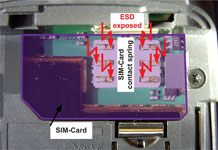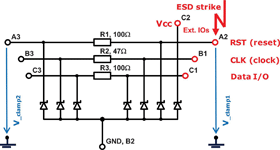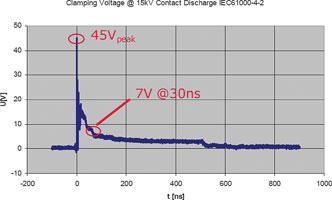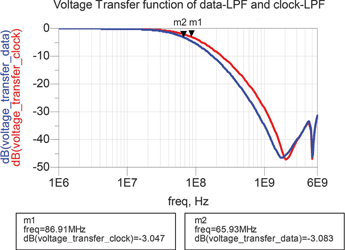
The SIM (Subscriber Identity Module) [2G] or Universal Integrated Circuit Card smartcard [3G] interface (UICC) is an essential building block of mobile devices.
No 2G or 3G mobile device would be able to make or receive calls without a working SIM or USIM card. The SIM card is being phased out in favour of the micro SIM card, which is smaller in size but electronically identical.
In a mobile device, the SIM card interface is heavily exposed to electrostatic discharge, especially when no card is inserted. Therefore it is essential to protect this interface (SIM card controller) from any physical damage or from generating soft errors, both of which can be caused by an ESD event or by EMI interference.
Based on its ESD-exposed location, the SIM card interface has to be proven against the so-called system level ESD test according to IEC61000-4-2, which is significantly more demanding than the standard device level test according to HBM JEDEC JESD 22-A115 (Figure 1). Currently, the industry demands a system level ESD robustness of ±8 kV contact as a minimum. However, more and more designers are stepping up to the ±15 kV contact discharge requirement.

According to the desired application, the SIM card can work in different voltage classes between +1,6 V and +5,5 V. Depending on the supply voltage used, the other lines – clock (CLK), I/O-, and of the RST(reset) corresponds accordantly.
Based on this, the breakdown voltage of the ESD protection elements (TVS diodes) has to be above +5,5 V.
Smartcard clock frequencies range from 1 MHz up to 20 MHz, depending on the SIM card’s supported clock speed. GSM standard clock speed is 4 MHz. In the mobile phone application, the I/O and the clock line should be limited in frequency to below 50 MHz to avoid EMI interference coming from the mobile phone’s PA. On the other hand, the EMI filter should not affect the rise time of the I/O signal or especially the clock signal.
Infineon has combined ESD and the EMI protection requirements into one circuit by integrating a ‘PI’ structured low-pass filter implemented into the clock, I/O and reset lines. This integrated solution (Figure 2) is far more efficient in its use of PCB space than an alternative solution requiring a set of three EMI low-pass filters with built-in ESD protection capability. Infineon’s BGF106c includes the complete ESD and EMI functionality to protect the SIM card interface plus the required ESD protection for the VCC line. All external I/Os are protected against ESD pulses of ±15 kV contact discharge according to IEC61000-4-2. The device is supplied in a lead-free and halogen-free wafer level package with a size of only 1,2 x 1,2 mm and a total height of 0,6 mm.

ESD performance of the BGF106c
The ESD performance of a protection device can be judged by the residual ESD voltage at the subsequent device (in this case, the SIM card controller). So the output voltage of the BGF106c in case of an IEC61000-4-2 ESD event (±15 kV contact discharge) is important. The very dynamic peak voltage (lasting only about 3 nanoseconds) is lower than 50 V and the more important clamping voltage after 30 nanoseconds is stable at 7 V. This value is very close to the normal working conditions of the SIM card (Figure 3).

EMI filter performance of the BGF106c
Characterising the EMI filter performance of the BGF106c in the mobile phone application circuit, the specific environment of source and load impedance and all parasitic effects have to be taken into account. On the other hand, it must be kept in mind that the signal integrity must not be affected by the EMI filter. Referring to strict GSM requirements, the rise time of the signals must not exceed 9% of the cycle time independent of the maximum system capacitance of 30 pF (Csimcard+Cdriver+CEMI+ Cparasitic). According to these basic conditions, the BGF106c (EMI filter capacitance 16,5 pF typ.) fulfils this requirement, even though the SIM card contributes 10 pF.
Based on the strict rise- and fall-time criteria, the frequency response of the entire SIM card link (including BGF106c and parasitics) can be calculated (Figure 4).

For more information contact Davis Moodley, Infineon, +27 (0)11 706 6099, www.infineon.com

© Technews Publishing (Pty) Ltd | All Rights Reserved